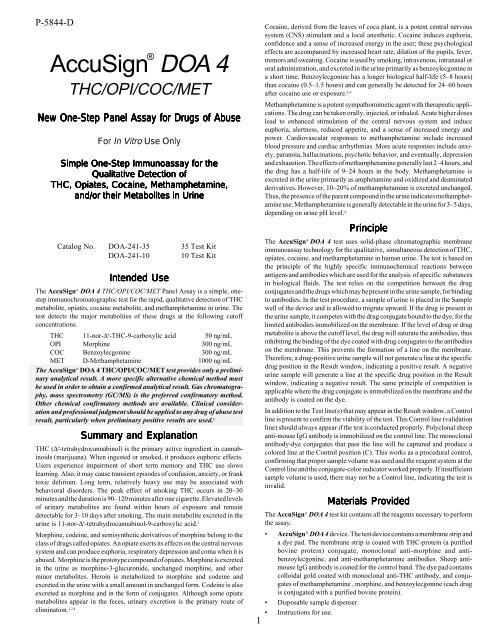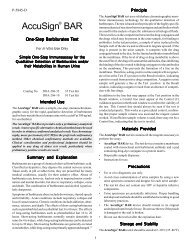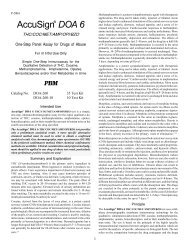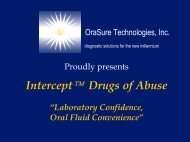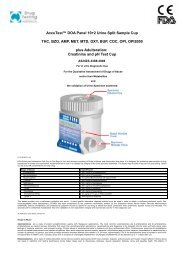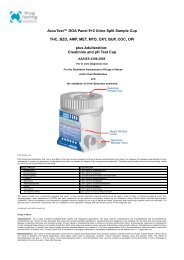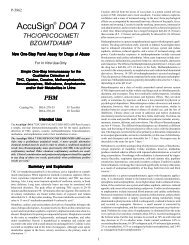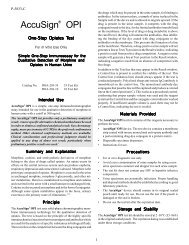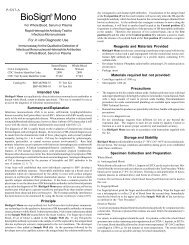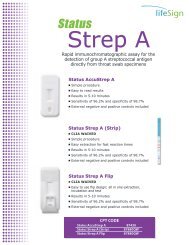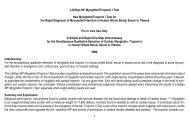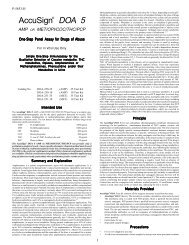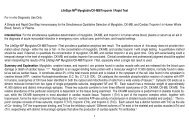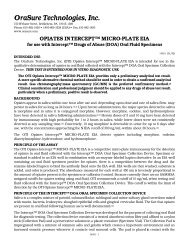AccuSign® DOA 4 - Drug Testing Australia
AccuSign® DOA 4 - Drug Testing Australia
AccuSign® DOA 4 - Drug Testing Australia
You also want an ePaper? Increase the reach of your titles
YUMPU automatically turns print PDFs into web optimized ePapers that Google loves.
P-5844-D<br />
AccuSign ® <strong>DOA</strong> 4<br />
THC/OPI/COC/MET<br />
New One-Step Panel Assay for <strong>Drug</strong>s of Abuse<br />
For In Vitro Use Only<br />
Simple One-Step Immunoassay for the<br />
Qualitative Detection of<br />
THC, Opiates, Cocaine, Methamphetamine,<br />
and/or their Metabolites in Urine<br />
Catalog No. <strong>DOA</strong>-241-35 35 Test Kit<br />
<strong>DOA</strong>-241-10 10 Test Kit<br />
Intended Use<br />
The AccuSign ® <strong>DOA</strong> 4 THC/OPI/COC/MET Panel Assay is a simple, onestep<br />
immunochromatographic test for the rapid, qualitative detection of THC<br />
metabolite, opiates, cocaine metabolite, and methamphetamine in urine. The<br />
test detects the major metabolites of these drugs at the following cutoff<br />
concentrations.<br />
THC 11-nor-∆ 9 -THC-9-carboxylic acid 50 ng/mL<br />
OPI Morphine 300 ng/mL<br />
COC Benzoylecgonine 300 ng/mL<br />
MET D-Methamphetamine 1000 ng/mL<br />
The AccuSign ® <strong>DOA</strong> 4 THC/OPI/COC/MET test provides only a preliminary<br />
analytical result. A more specific alternative chemical method must<br />
be used in order to obtain a confirmed analytical result. Gas chromatography,<br />
mass spectrometry (GC/MS) is the preferred confirmatory method.<br />
Other chemical confirmatory methods are available. Clinical consideration<br />
and professional judgment should be applied to any drug of abuse test<br />
result, particularly when preliminary positive results are used. 1<br />
Summary and Explanation<br />
THC (∆ 9 -tetrahydrocannabinol) is the primary active ingredient in cannabinoids<br />
(marijuana). When ingested or smoked, it produces euphoric effects.<br />
Users experience impairment of short term memory and THC use slows<br />
learning. Also, it may cause transient episodes of confusion, anxiety, or frank<br />
toxic delirium. Long term, relatively heavy use may be associated with<br />
behavioral disorders. The peak effect of smoking THC occurs in 20–30<br />
minutes and the duration is 90–120 minutes after one cigarette. Elevated levels<br />
of urinary metabolites are found within hours of exposure and remain<br />
detectable for 3–10 days after smoking. The main metabolite excreted in the<br />
urine is 11-nor-∆ 9 -tetrahydrocannabinol-9-carboxylic acid. 2<br />
Morphine, codeine, and semisynthetic derivatives of morphine belong to the<br />
class of drugs called opiates. An opiate exerts its effects on the central nervous<br />
system and can produce euphoria, respiratory depression and coma when it is<br />
abused. Morphine is the prototype compound of opiates. Morphine is excreted<br />
in the urine as morphine-3-glucuronide, unchanged morphine, and other<br />
minor metabolites. Heroin is metabolized to morphine and codeine and<br />
excreted in the urine with a small amount in unchanged form. Codeine is also<br />
excreted as morphine and in the form of conjugates. Although some opiate<br />
metabolites appear in the feces, urinary excretion is the primary route of<br />
elimination. 1,2,4 1<br />
Cocaine, derived from the leaves of coca plant, is a potent central nervous<br />
system (CNS) stimulant and a local anesthetic. Cocaine induces euphoria,<br />
confidence and a sense of increased energy in the user; these psychological<br />
effects are accompanied by increased heart rate, dilation of the pupils, fever,<br />
tremors and sweating. Cocaine is used by smoking, intravenous, intranasal or<br />
oral administration, and excreted in the urine primarily as benzoylecgonine in<br />
a short time. Benzoylecgonine has a longer biological half-life (5–8 hours)<br />
than cocaine (0.5–1.5 hours) and can generally be detected for 24–60 hours<br />
after cocaine use or exposure. 3,4<br />
Methamphetamine is a potent sympathomimetic agent with therapeutic applications.<br />
The drug can be taken orally, injected, or inhaled. Acute higher doses<br />
lead to enhanced stimulation of the central nervous system and induce<br />
euphoria, alertness, reduced appetite, and a sense of increased energy and<br />
power. Cardiovascular responses to methamphetamine include increased<br />
blood pressure and cardiac arrhythmias. More acute responses include anxiety,<br />
paranoia, hallucinations, psychotic behavior, and eventually, depression<br />
and exhaustion. The effects of methamphetamine generally last 2–4 hours, and<br />
the drug has a half-life of 9–24 hours in the body. Methamphetamine is<br />
excreted in the urine primarily as amphetamine and oxidized and deaminated<br />
derivatives. However, 10–20% of methamphetamine is excreted unchanged.<br />
Thus, the presence of the parent compound in the urine indicates methamphetamine<br />
use. Methamphetamine is generally detectable in the urine for 3–5 days,<br />
depending on urine pH level. 4<br />
Principle<br />
The AccuSign ® <strong>DOA</strong> 4 test uses solid-phase chromatographic membrane<br />
immunoassay technology for the qualitative, simultaneous detection of THC,<br />
opiates, cocaine, and methamphetamine in human urine. The test is based on<br />
the principle of the highly specific immunochemical reactions between<br />
antigens and antibodies which are used for the analysis of specific substances<br />
in biological fluids. The test relies on the competition between the drug<br />
conjugates and the drugs which may be present in the urine sample, for binding<br />
to antibodies. In the test procedure, a sample of urine is placed in the Sample<br />
well of the device and is allowed to migrate upward. If the drug is present in<br />
the urine sample, it competes with the drug conjugate bound to the dye, for the<br />
limited antibodies immobilized on the membrane. If the level of drug or drug<br />
metabolite is above the cutoff level, the drug will saturate the antibodies, thus<br />
inhibiting the binding of the dye coated with drug conjugates to the antibodies<br />
on the membrane. This prevents the formation of a line on the membrane.<br />
Therefore, a drug-positive urine sample will not generate a line at the specific<br />
drug position in the Result window, indicating a positive result. A negative<br />
urine sample will generate a line at the specific drug position in the Result<br />
window, indicating a negative result. The same principle of competition is<br />
applicable where the drug conjugate is immobilized on the membrane and the<br />
antibody is coated on the dye.<br />
In addition to the Test line(s) that may appear in the Result window, a Control<br />
line is present to confirm the viability of the test. This Control line (validation<br />
line) should always appear if the test is conducted properly. Polyclonal sheep<br />
anti-mouse IgG antibody is immobilized on the control line. The monoclonal<br />
antibody-dye conjugates that pass the line will be captured and produce a<br />
colored line at the Control position (C). This works as a procedural control,<br />
confirming that proper sample volume was used and the reagent system at the<br />
Control line and the conjugate-color indicator worked properly. If insufficient<br />
sample volume is used, there may not be a Control line, indicating the test is<br />
invalid.<br />
Materials Provided<br />
The AccuSign ® <strong>DOA</strong> 4 test kit contains all the reagents necessary to perform<br />
the assay.<br />
• AccuSign ® <strong>DOA</strong> 4 device. The test device contains a membrane strip and<br />
a dye pad. The membrane strip is coated with THC-protein (a purified<br />
bovine protein) conjugate, monoclonal anti-morphine and antibenzoylecgonine,<br />
and anti-methamphetamine antibodies. Sheep antimouse<br />
IgG antibody is coated for the control band. The dye pad contains<br />
colloidal gold coated with monoclonal anti-THC antibody, and conjugates<br />
of methamphetamine , morphine, and benzoylecgonine (each drug<br />
is conjugated with a purified bovine protein).<br />
• Disposable sample dispenser.<br />
• Instructions for use.
Add 3 drops<br />
(110 µL)<br />
Read in 5–10<br />
minutes<br />
®<br />
AccuSign<br />
<strong>DOA</strong> 4<br />
Date<br />
ID<br />
C<br />
THC<br />
OPI<br />
COC<br />
MET<br />
Sample<br />
3 drops<br />
No Line = +<br />
Line = –<br />
CONTROL (VALIDATION) LINE (C).<br />
The Control/Validation line indicates:<br />
1. If the proper amount of sample was used;<br />
2. If the sample wicked;<br />
3. If the procedure was followed properly.<br />
If no control line appears, the test is NOT VALID.<br />
Repeat the test using a new device, and follow the<br />
procedure carefully.<br />
C<br />
THC<br />
OPI<br />
COC<br />
MET<br />
(2) (3) (4) (5)<br />
OR<br />
C<br />
OR<br />
C<br />
OR<br />
THC<br />
OPI<br />
COC<br />
MET<br />
THC<br />
OPI<br />
COC<br />
MET<br />
C<br />
THC<br />
OPI<br />
COC<br />
MET<br />
Sample<br />
3 drops<br />
C<br />
THC<br />
OPI<br />
COC<br />
MET<br />
ID<br />
Date<br />
®<br />
AccuSign<br />
<strong>DOA</strong> 4<br />
(1)<br />
THC (–)<br />
OPI (–)<br />
COC (–)<br />
MET (+)<br />
THC (+)<br />
OPI (–)<br />
COC (+)<br />
MET (–)<br />
THC (–)<br />
OPI (+)<br />
COC (–)<br />
MET (–)<br />
INVALID<br />
No Line = +<br />
Line = –<br />
Negative (–) = Control line and Specific <strong>Drug</strong> line<br />
Positive (+) = Control line only; No Specific <strong>Drug</strong> line<br />
Precautions<br />
• For in vitro diagnostic use only.<br />
• Avoid cross contamination of urine samples by using a new<br />
urine specimen container and dropper for each urine sample.<br />
• This test kit does not contain any HIV or hepatitis infective components.<br />
• Urine specimens are potentially infectious. Proper handling and disposal<br />
methods should be followed, according to good laboratory practices.<br />
• The AccuSign ® device should remain in its original sealed pouch until<br />
ready for use.<br />
• Do not use the test kit after the expiration date.<br />
Storage and Stability<br />
The AccuSign ® <strong>DOA</strong> 4 test kit should be stored at 2–30 ° C (35–86 ° F) in the<br />
original sealed pouch. The expiration dating was established under these<br />
storage conditions.<br />
Specimen Collection and Preparation<br />
Approximately 110 µL of urine sample is required for each test. Fresh urine<br />
specimens do not require any special handling or pretreatment. Specimens<br />
should be collected in a clean glass or plastic container. If testing will not be<br />
performed immediately, specimens should be refrigerated (2–8 ° C) or frozen.<br />
Specimens should be brought to room temperature before testing.<br />
Specimens containing a large amount of particulate matter may give inconsistent<br />
test results. These specimens should be clarified by centrifuging or<br />
allowing to settle before testing.<br />
Test Procedure<br />
The test procedure consists of adding the urine sample to the Sample well of<br />
the device and watching for the appearance of colored lines in the result<br />
window.<br />
Test Protocol<br />
1. For each test, open one AccuSign ® <strong>DOA</strong> 4 pouch<br />
and label the AccuSign ® <strong>DOA</strong> 4 device with the<br />
patient ID.<br />
2. Holding the dropper vertically, dispense 3 full drops<br />
(110 µL) of the urine sample into the Sample well.<br />
3. Read the result after 5 minutes, but within 10 minutes.<br />
Interpretation of Results<br />
Negative: The appearance of a reddish-purple Control line (C) and a line<br />
for a specific drug indicates a negative test result; i.e., no drug above the cutoff<br />
level has been detected. The color intensities of the Control line and a specific<br />
drug line may not be equal. Any faint line at a specific drug name in the Result<br />
window, visible in 10 minutes, should be interpreted as negative. A negative<br />
test result does not indicate the absence of drug in the sample; it only indicates<br />
the sample does not contain drug above the cutoff level in qualitative terms.<br />
Positive: The appearance of a reddish-purple Control line and no distinct<br />
line at a specific drug name indicates the test result is positive for that drug (i.e.,<br />
the specimen contains the drug at a concentration above the cutoff level). A<br />
positive test result does not provide any indication of the level of intoxication<br />
or urinary concentration of the drug in the sample; it only indicates the sample<br />
contains drug above the cutoff level in qualitative terms.<br />
Invalid: A distinct Control line (C) should always appear. The test is invalid<br />
if no Control line forms at the C position. Such tests should be repeated with<br />
a new AccuSign ® <strong>DOA</strong> 4 test device.<br />
Examples of possible results are shown in the diagram above.<br />
(1) THC (–), Opiates (–), Cocaine (–), Methamphetamines (–): Five<br />
reddish-purple lines—one Control line at the C position and one each at<br />
the THC, OPI, COC, and MET positions.<br />
(2) THC (–), Opiates (–), Cocaine (–), Methamphetamines (+): Four<br />
reddish-purple lines—one Control line at the C position and one line each<br />
at the THC, OPI, and COC positions; no line at the MET position.<br />
(3) THC (+), Opiates (–), Cocaine (+), Methamphetamines (–): Three<br />
reddish-purple lines—one Control line at the C position, one line each at<br />
the OPI and MET positions; no lines at the THC and COC positions.<br />
(4) THC (–), Opiates (+), Cocaine (–), Methamphetamines (–): Four<br />
reddish-purple lines—one Control line at the C position and one line each<br />
at the THC, COC, and MET positions; no line at the OPI position.<br />
(5) Invalid: No line at the C position.<br />
There are other possible results, depending on the combinations of drugs<br />
present in the urine sample.<br />
Limitations<br />
• The test is designed for use with unadulterated urine only.<br />
• There is a possibility that factors such as technical or procedural errors,<br />
as well as other substances in the urine sample than those listed in Table<br />
4 below, may interfere with the test and cause erroneous results.<br />
• Adulterants, such as bleach and/or alum, in urine specimens may produce<br />
2
erroneous results regardless of the method of analysis. If adulteration is<br />
suspected, the test should be repeated with a new sample.<br />
• The test result read after 10 minutes may not be consistent with the original<br />
reading obtained within the 10 minute reading period. The test result must<br />
be read within 10 minutes of sample application.<br />
• Certain medications containing opiates or opiate derivatives or methamphetamines<br />
may produce a positive result. Additionally, foods and tea<br />
containing poppy products and/or coca leaves may produce a positive<br />
result. Prolonged passive smoking of THC may also produce a positive<br />
result.<br />
User Quality Control<br />
Internal Control: Each AccuSign ® <strong>DOA</strong> 4 test device has a built-in control.<br />
The Control line is an internal positive procedural control. A distinct reddishpurple<br />
Control line should appear in the Control position, if the test procedure<br />
is performed properly, an adequate sample volume is used, the sample and<br />
reagent are wicking on the membrane, and the test reagents at the control line<br />
and the conjugate-color indicator are reactive. In addition, if the test is<br />
performed correctly and the device is working properly, the background in the<br />
Result window will become clear and provide a distinct result. This may be<br />
considered an internal negative procedural control.<br />
The positive and negative procedural controls contained in each AccuSign ®<br />
<strong>DOA</strong> 4 test device satisfy the requirements of testing a positive control and a<br />
negative control on a daily basis. If the Control line does not appear in the<br />
Control position, the test is invalid and a new test should be performed. If the<br />
problem persists, contact PBM for technical assistance.<br />
External Control: External controls may also be used to assure that the<br />
reagents are working properly and that the assay procedure is followed<br />
correctly. It is recommended that a control be tested at regular intervals as good<br />
laboratory testing practice. For information on how to obtain controls, contact<br />
PBM’s Technical Services.<br />
Expected Values<br />
AccuSign ® <strong>DOA</strong> 4 is a qualitative assay. The amount of drugs and metabolites<br />
present in urine cannot be estimated by the assay. The assay results distinguish<br />
positive from negative samples. Positive results indicate the samples contain<br />
the specific drug above the cutoff concentration.<br />
Performance Characteristics<br />
The AccuSign ® <strong>DOA</strong> 4 Panel Assay detects THC metabolite, opiates, cocaine<br />
metabolite, methamphetamine at cutoff levels based on the recommendations<br />
of the SAMHSA for screening of these drugs in urine.<br />
THC 11-nor-∆ 9 -THC-9-carboxylic acid 50 ng/mL<br />
OPI Morphine 300 ng/mL<br />
COC Benzoylecgonine 300 ng/mL<br />
MET D-Methamphetamine 1000 ng/mL<br />
The accuracy of AccuSign ® <strong>DOA</strong> 4 was evaluated in comparison to a<br />
commercially available immunoassay (Syva ® EMIT ® II) for each of these four<br />
drugs. The results are shown in Table 1.<br />
Table 1. Accuracy: Comparison of AccuSign ® <strong>DOA</strong> 4 with<br />
Syva ® EMIT ® II Assay<br />
Syva ® EMIT ® II (THC)<br />
Positive Negative TOTAL<br />
AccuSign ® Positive 327 5 332<br />
<strong>DOA</strong> 4 (THC) Negative 13 655 668<br />
TOTAL 340 660 1000<br />
Syva ® EMIT ® II (OPI)<br />
Positive Negative TOTAL<br />
AccuSign ® Positive 249 0 249<br />
<strong>DOA</strong> 4 (OPI) Negative 1 716 717<br />
TOTAL 250 716 966<br />
Syva ® EMIT ® II (COC)<br />
Positive Negative TOTAL<br />
AccuSign ® Positive 369 3 372<br />
<strong>DOA</strong> 4 (COC) Negative 16 635 651<br />
TOTAL 385 638 1023<br />
Syva ® EMIT ® II (AMP/MET)<br />
Positive Negative TOTAL<br />
AccuSign ® Positive 108 0 108<br />
<strong>DOA</strong> 4 (MET) Negative 28 184 212<br />
TOTAL 136 184 320<br />
Relative Sensitivity Relative Specificity<br />
THC 96.2% (327/340) 99.2% (655/660)<br />
Opiates 99.6% (249/250) > 99% (716/716)<br />
Cocaine 95.8% (369/385) 99.5% (635/638)<br />
Methamphetamine 79.4% (108/136) > 99% (184/184)<br />
In a separate study, AccuSign ® <strong>DOA</strong> 4 was evaluated against specimens<br />
confirmed as positive by GC/MS, for each of the four drugs. The results<br />
demonstrate the excellent correlation of AccuSign ® <strong>DOA</strong> 4 with GC/MS (99%<br />
agreement, Table 2).<br />
Table 2. Accuracy: Comparison of AccuSign ® <strong>DOA</strong> 4 with<br />
GC/MS Assay<br />
AccuSign ® GC/MS<br />
THC Positive 87 88<br />
Negative 1 0<br />
OPI Positive 73 74<br />
Negative 1 0<br />
COC Positive 77 78<br />
Negative 1 0<br />
MET Positive 88 89<br />
Negative 1 0<br />
Precision and Accuracy<br />
The precision of the AccuSign ® <strong>DOA</strong> 4 Panel Assay was determined by<br />
carrying out the test with serially diluted standard drug solutions. About 98%<br />
of the samples containing 25% over the cutoff level of cocaine, opiates,<br />
methamphetamine and about 90% of the samples containing THC concentration<br />
25% over the cutoff level consistently showed positive results.<br />
The study also included over 40 samples ± 25% cutoff level as a challenge of<br />
cutoff precision. These results were found to be consistently in agreement with<br />
expected test results.<br />
Distribution of Random Error:<br />
Twenty (20) blind samples prepared by spiking various concentrations of<br />
cocaine, THC, morphine, or methamphetamine were separately tested by two<br />
operators. The test results from the two operators showed complete agreement.<br />
Reproducibility<br />
The reproducibility of the test results of the AccuSign ® <strong>DOA</strong> 4 Panel Assay<br />
was examined at three different sites using a total of 15 blind controls,<br />
consisting of 5 negative samples, 5 moderately positive samples, and 5 strongly<br />
positive samples (i.e., a concentration 3 times the cutoff level). The results<br />
obtained at these three sites with these controls demonstrated 100% agreement<br />
with each other.<br />
Specificity<br />
The following table lists compounds that are detected by the AccuSign ® <strong>DOA</strong><br />
4 test. The specificity of the AccuSign ® <strong>DOA</strong> 4 test was determined by adding<br />
various drugs and drug metabolites to drug-negative urine specimens and<br />
testing with the AccuSign ® <strong>DOA</strong> 4 test kit. The results are expressed in terms<br />
of the concentration required to produce a positive result (Table 3).<br />
3
Table 3. Specificity<br />
Concentration % Cross-<br />
Compound (ng/mL) reactivity<br />
THC<br />
Cannabinol 50,000 0.1<br />
11-nor-∆ 8 -THC-9-COOH 250 20<br />
11-nor-∆ 9 -THC-9-COOH 50 100<br />
∆ 8 -THC 25,000 0.2<br />
∆ 9 -THC 15,000 0.3<br />
11-hydroxy-∆ 9 -THC 10,000 0.5<br />
OPI<br />
Codeine 300 100<br />
Hydrocodone 500 60<br />
Hydromorphone 600 50<br />
Levophanol 5,000 6<br />
Meperidine 80,000 0.4<br />
Morphine 300 100<br />
Morphine-3-ß-D-glucuronide 500 60<br />
Nalorphine 1,000 30<br />
Naloxane 100,000 0.3<br />
Norcodeine 60,000 0.5<br />
Oxycodone 20,000 1.5<br />
Oxymorphone 60,000 0.5<br />
Procaine HCl 100,000 0.3<br />
Thebaine 5,000 6<br />
COC<br />
Benzoylecgonine 300 100<br />
Cocaine HCl >100,000<br />
Ecgonine HCl 50,000 0.6<br />
MET<br />
D-Amphetamine 200,000 0.5<br />
D,L-Amphetamine >200,000<br />
(–)Ephedrine 200,000 0.5<br />
(+)Ephedrine 200,000 0.5<br />
D-Methamphetamine 1,000 100<br />
p-OH-Methamphetamine >200,000<br />
Methylenedioxyamphetamine >200,000<br />
Methylenedioxymethamphetamine 2,000 50<br />
The following compounds show no cross-reactivity when tested with<br />
AccuSign ® <strong>DOA</strong> 4 at a concentration of 100 µg/mL. (Table 4.)<br />
Table 4.<br />
Acetaminophen<br />
Acetylsalicylate<br />
Aminopyrine<br />
Amitriptyline<br />
Amobarbital<br />
Amoxapine<br />
Ampicillin<br />
Apomorphine<br />
Ascorbic acid<br />
Atropine<br />
Benzocaine<br />
Butabarbital<br />
Chlordiazepoxide<br />
Chlorpheniramine<br />
Chlorpromazine<br />
Chloroquine<br />
Non Cross-Reacting Compounds<br />
Dextropropoxyphene<br />
Diazepam<br />
Diphenylhydantoin<br />
Epinephrine<br />
Erythromycin<br />
Estriol<br />
Gentisic acid<br />
Glutethimide<br />
Guaiacol glycerol<br />
ether<br />
Hydrochlorothiazide<br />
Imipramine<br />
Lidocaine<br />
Methadone<br />
Methaqualone<br />
Methyprylon<br />
Naproxen<br />
Norethindrone<br />
Penicillin<br />
Pentobarbital<br />
Phencyclidine<br />
Phenolbutazone<br />
Phenylpropanolamine<br />
Prednisone<br />
Secobarbital<br />
Tetracycline<br />
Tetrahydrozoline<br />
Trifluoperazine<br />
Tryptamine<br />
Zomepirac<br />
References<br />
1. Hawks RL, Chiang CN, eds. Urine <strong>Testing</strong> for <strong>Drug</strong>s of Abuse. National<br />
Institute on <strong>Drug</strong> Abuse (NIDA), Research Monograph 73; 1986.<br />
2. Tietz, Norbert W. Textbook of Clinical Chemistry. W.B. Saunders<br />
Company. 1986.<br />
3. Ambre J. J. Anal. Toxicol. 1985;9:241–5.<br />
4. Baselt RC. Disposition of Toxic <strong>Drug</strong>s and Chemicals in Man. 2nd Ed.,<br />
Davis, CA: Biomedical Publ.; 1982.<br />
Symbols Key<br />
Manufactured by<br />
CE Mark<br />
Authorized Representative<br />
In Vitro Diagnostic Medical Device<br />
Catalog Number<br />
Consult Instructions for Use<br />
Batch Code<br />
“Use By” date in year-month-day format<br />
Temperature Limitation<br />
Contains sufficient for tests<br />
Do not reuse<br />
Contents<br />
Test Device<br />
Transfer Pipette<br />
Instructions for Use<br />
One-step immunochromatographic Assay for<br />
the Detection of <strong>Drug</strong>s of Abuse in Urine<br />
Marijuana/Opiates/Cocaine/Methamphetamine Test<br />
AccuSign ® is a Registered Trademark of Princeton BioMeditech Corporation.<br />
Patent No.: 5,559,041<br />
© 2000 PBM<br />
Printed in U.S.A.<br />
Revised Oct 2003<br />
P-5844-D 1013BL<br />
4<br />
MT Promedt Consulting GmbH<br />
Eisenbahnstrasse 2<br />
D-66386 St. Ingbert<br />
Germany<br />
+49-68 94-58 10 20<br />
Manufactured by<br />
Princeton BioMeditech Corporation<br />
Princeton, NJ 08543-7139 U.S.A.<br />
1-732-274–1000 www.pbmc.com


